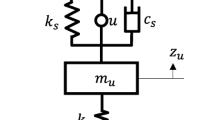Abstract
In vehicles with active suspensions, by reducing the tire deflections, handling stability can be improved, and by reducing vertical acceleration of the vehicle body, ride comfort can be improved. In general, for hard road bumps, if handling stability is improved by using LQ controllers, ride comfort may deteriorate for not so hard road bumps. To overcome the problem, we propose a controller in which handling stability can be improved only when handling stability may be likely to be deteriorated.




Similar content being viewed by others
References
Qiang W, Masahiro O, Zhao J, Toshihiro K (2005) Adaptive lane keeping control of vehicles. In: Proceedings of SICE Annual Conference 2005, Okayama, Japan, pp 2200–2204
Wang Q, Oya M, Kobayashi T (2008) Adaptive lane keeping control for combination vehicles without measurement of lateral velocity. In: Proceedings of Advances in Vehicle Control and Safety, Kobe, Japan, pp 331–336
Toro O, Becsi T, Aradi S (2016) Design of lane keeping algorithm of autonomous vehicle. Period Polytech Transp Eng 44(1):60–68
Sun W, Gao H, Kaynak O (2011) Finite frequency H\(_\infty\) control for vehicle active suspension systems. IEEE Trans Control Syst Technol 19(2):416–422
Koch G, Kloiber T (2014) Driving state adaptive control of an active vehicle suspension system. IEEE Trans Control Syst Technol 22(1):44–57
Brezas P, Smith MC (2014) Linear quadratic optimal and risk-sensitive control for vehicle active suspensions. IEEE Trans Control Syst Technol 22(2):543–556
Metered H, Sika Z (2015) Vibration control of vehicle active suspension using sliding mode under parameters uncertainty. J Traffic Logist Eng 3(2):136–142
Deshpande VS, Shendge PD, Phadke SB (2016) Dual objective active suspension system based on a novel nonlinear disturbance compensator. Veh Syst Dyn 54(9):1269–1290
Jagat JR, Michael D, Hamid RK, Kalyana CV (2017) Output feedback active suspension control with higher order terminal sliding mode. IEEE Trans Ind Electron 64(2):1392–1403
Jenq-Lang W (2017) A simultaneous mixed LQR/H\(\infty\) control approach to the design of reliable active suspension controllers. Asian J Control 19(2):415–427
Xue W, Li K, Chen Q, Liu G (2019) Mixed FTS/H\(\infty\) control of vehicle active suspensions with shock road disturbance. Veh Syst Dyn 57(6):841–854
Lin B, Xiaoyu S, Li X (2019) Fuzzy sliding mode control for active suspension system with proportional differential sliding mode observer. Asian J Control 21(1):264–276
Cao Z, Zhao W, Hou X, Chen Z (2020) Multi-objective robust control for vehicle active suspension systems via parameterized controller. IEEE Access 8:7455–7465
Meng Q, Chen C-C, Wang P, Sun Z-Y, Li B (2021) Study on vehicle active suspension system control method based on homogeneous domination approach. Asian J Control 23:561–571
Lin J-S, Huang C-J (2004) Nonlinear backstepping active suspension design applied to a half-car model. Veh Syst Dyn 42(6):373–393
Oya M, Harada H, Araki Y (2007) An active suspension controller achieving the best ride comfort at any specified location on a vehicle. J Syst Des Dyn 2:245–256
Oya M, Tsuchida Y, Wang Q, Taira Y (2008) Adaptive active suspension controller achieving the best ride comfort at any specified location on vehicles with parameter uncertainties. Int J Adv Mechatron Syst 1(2):125–136
Shuang L, Tian Z, Dingxuan Z, Ruolan H, Mengke Y (2020) Strongly perturbed sliding mode adaptive control of vehicle active suspension system considering actuator nonlinearity. Veh Syst Dyn 60:597–616
Oya M, Okura R, Shibata H, Okumura K (2011) Robust control of vehicle active suspension systems. ICIC Express Lett 6:1019–1026
Shao-Bo L, Li Y-N, Zheng S-BCL, Seong M-S (2011) Integrated control on MR vehicle suspension system associated with braking and steering control. Veh Syst Dyn 49(1–2):361–380
Sun W, Gao H, Yao B (2013) Adaptive robust vibration control of full-car active suspensions with electrohydraulic actuators. EEE Trans Control Syst Technol 21(6):2417–2422
Gohrle C, Schindler A, Wagner A, Sawodny O (2014) Design and vehicle implementation of preview active suspension controllers. IEEE Trans Control Syst Technol 22(3):1135–1142
Hu Y, Chen MZQ, Hou Z (2015) Multiplexed model predictive control for active vehicle suspensions. Int J Control 88(2):347–363
Attia T, Vamvoudakis KG, Kochersberger K, Bird J, Furukawa T (2019) Simultaneous dynamic system estimation and optimal control of vehicle active suspension. Veh Syst Dyn 57(10):1467–1493
Author information
Authors and Affiliations
Corresponding author
About this article
Cite this article
Wang, Y., Oya, M. & Taira, Y. A new active suspension control scheme for vehicles considering steering stability. Artif Life Robotics 27, 812–817 (2022). https://doi.org/10.1007/s10015-022-00786-3
Received:
Accepted:
Published:
Issue Date:
DOI: https://doi.org/10.1007/s10015-022-00786-3



